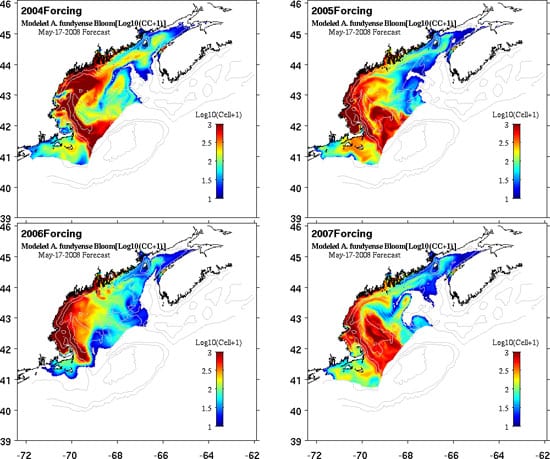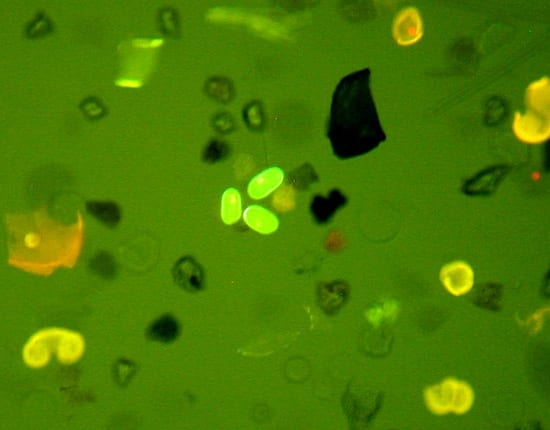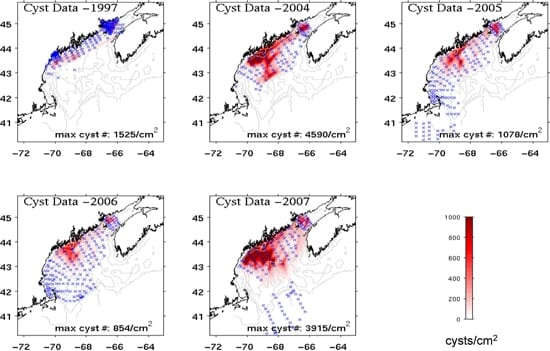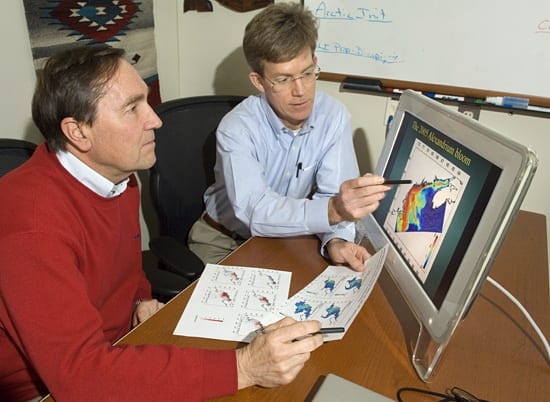In Computer Models and Seafloor Observations, Researchers See Potential for Significant 2008 “Red Tide” Season
April 24, 2008
The end of April usually brings the first signs of harmful algae in New England waters, and this year, a research team led by the Woods Hole Oceanographic Institution (WHOI) is preparing for a potentially big bloom.
A combination of abundant beds of algal seeds and excess winter precipitation have set the stage for a harmful algal bloom similar to the historic “red tide” of 2005, according to WHOI biologist Don Anderson, principal investigator of the Gulf of Maine Toxicity (GOMTOX) study. The 2005 bloom shut down shellfish beds from the Bay of Fundy to Martha’s Vineyard for several months and caused an estimated $50 million in losses to the Massachusetts shellfish industry alone.
Weather patterns and ocean conditions over the next few months will determine whether this year’s algal growth approaches the troubles of 2005.
Oceanographers Dennis McGillicuddy (WHOI) and Ruoying He (North Carolina State University) are several years along in the development of a computer model to predict the intensity and location of blooms of the toxic algae Alexandrium fundyense in the Gulf of Maine.
Scientists are reluctant to make a “forecast” of precisely where and when the bloom will make landfall because bloom transport depends on weather events that cannot be predicted months in advance. However, colleagues in coastal management and fisheries believe that the regional-scale, seasonal forecast that McGillicuddy and colleagues produce can be useful in preparing for contingencies.
“With advance warning of a potentially troublesome year for algae, shellfish farmers and fishermen might shift the timing of their harvest or postpone plans for expansion of aquaculture beds,” said Anderson, a WHOI senior scientist in the Biology Department and director of the Coastal Ocean Institute.
“Restaurants might make contingency plans for supplies of seafood during the summer,” Anderson added, “and state agencies can ensure they have adequate staff for the significant monitoring efforts that might be required to protect public health and the shellfish industry.”
Seeds or “cysts” of A. fundyense naturally germinate and turn into cells that swim up from the seafloor around April 1 of each year. By the end of April, cells usually begin to appear in large numbers in the waters off coastal Maine.
The algae are notorious for producing a toxin that accumulates in clams, mussels, and other shellfish and can cause paralytic shellfish poisoning (PSP) in humans who consume them.
According to a seafloor survey conducted in the fall of 2007 by Anderson’s team, the number of Alexandrium cysts—the dormant, seed-like stage of the algae’s life-cycle—is more than 30 percent higher than what was observed in the sediments prior to the historic bloom of 2005.
The seed beds were especially rich in mid-coast Maine, origin of many of the cells that affect western Maine, New Hampshire, and Massachusetts.
Other environmental factors then determine the extent to which the blooms spread down the New England coast. Much of the Northeastern United States was hit with record- or above-average rain and snowfall this winter, which will likely provide a larger than normal pulse of fresh water and nutrients into coastal waters this spring. The blend of nutrients and fresh water into salty sea water can improve growing conditions for algae.
“Our hypothesis is that cyst abundance is an indicator of the magnitude of the bloom,” said McGillicuddy, a senior scientist in the WHOI Department of Applied Ocean Physics and Engineering. “If there is a large bloom offshore, then wind patterns and ocean currents in the next few weeks will determine whether it will be transported onshore and have an effect on coastal shellfish resources.”
The research team has run its computer model through four scenarios, using the predominant wind patterns and ocean conditions from each year since 2004. Toxicity levels during those years have ranged from relatively low in 2004 and 2007 to extremely high levels in 2005 and 2006.
Coastal exposure to the blooms is worst for scenarios in which the spring weather was dominated by strong northeast winds, which tend to drive Alexandrium cells toward the southern New England coast. When southwesterlies dominated, the algae tend to stay offshore. Even when there are a lot of cells and toxicity, the effect can be confined to offshore waters.
Anderson, McGillicuddy, He, Couture, and other scientists regularly share their field observations and models with more than 80 coastal resource and fisheries managers in six states and at the National Oceanic and Atmospheric Administration (NOAA), the Environmental Protection Agency, and the Food and Drug Administration (which oversees food safety).
“The models are very important when we consider the big picture of what a season might look like,” said Darcie Couture, director of Biotoxin Monitoring for the Maine Department of Marine Resources. “We used to feel like we were operating in the dark, without any awareness of what a season might bring.”
“Now we have a bit of an advance warning that we can blend with our local knowledge and intuition about the shellfishing industry,” Couture added. “Everyone appreciates more information, as it gives the fishermen and state officials a chance to decide if or how to prepare for the season.”
McGillicuddy and more than a dozen students, technicians, and scientists from WHOI, the University of Maine, and the University of Massachusetts-Dartmouth departed from Woods Hole, Mass., on April 28 on the research vessel Oceanus on the first of four expeditions to take stock of this year’s bloom and to study the causes of several recent blooms in the historically fertile fishing grounds around Georges Bank.
Biologists and oceanographers were surprised by the substantial scale and persistence of Alexandrium blooms observed on Georges Bank last year.
The research into blooms of the harmful algae Alexandrium is supported by NOAA’s Center for Sponsored Coastal Ocean Research, and the National Institutes of Health and the National Science Foundation (through the Woods Hole Center for Oceans and Human Health). Additional work examining other species of toxic algae in the Gulf and on Georges Bank is supported by the NOAA Oceans and Human Health Initiative (OHHI).
The Woods Hole Oceanographic Institution is a private, independent organization in Falmouth, Mass., dedicated to marine research, engineering, and higher education. Established in 1930 on a recommendation from the National Academy of Sciences, its primary mission is to understand the oceans and their interaction with the Earth as a whole, and to communicate a basic understanding of the oceans’ role in the changing global environment.




